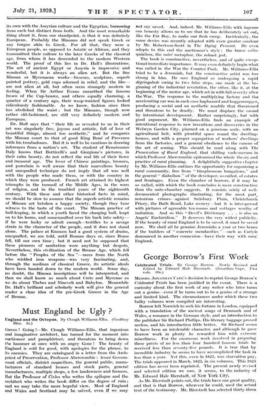Must England be Ugly ?
GOING ! Going !—Mr. Clough Williams-Ellis, that ingenious and imaginative architect, has turned for the moment into auctioneer and pamphleteer, and threatens to bring down the hammer at once with an angry Gone ! The beauty of England is sold for good, with apologies for the phrase, to its enemies. They are catalogued in a letter from the Arch- priest of Preservation, Professor Abercrombie : lesser Govern- ment officials, district councillors, the general public, manu- facturers of standard houses and stock parts, general manufacturers, multiple shops, a few landowners and farmers. But the Professor of Civics who writes the epilogue and the architect who writes the book differ on the degree of ruin ; and we may take the more hopeful view. Most of England and Wales and Scotland may be salved, even if we .may not say saved. And, indeed, Mr. Williams-Ellis with ingenue ous honesty allows us to see that he has deliberately set out; like the Fat Boy, to make our flesh creep. Incidentally, the same device was recently adopted with even greater candour by Mr. Robertson-Scott. in The Dying Peasant. He even adopts to this end the auctioneer's style : the brave collo- quialism, the outré metaphor, the robust jest.
The book is constructive, nevertheless, and of quite excep- tional immediate importance. It may even definitCly begin what was called in the War the Counter Push. Mr. Willianis-Ellis tried to be a Jeremiah, but the constructive artist was too strong in him. He sees England as undergoing a rapid degringolade owing to two false steps, one made at the be- ginning of the industrial revolution, the other, like it, at the beginning of the motor age, which set in with full severity after the War. The response to the multiplying factory and the accelerating car was in each case haphazard and huggermugger, producing a social and an aesthetic muddle that threatened and threatens to be deadly. We must displace the casual by intentional development. Rather surprisingly, but with good argument, Mr. Williams-Ellis finds an example of intentional response to new inventions and discoveries in the Welwyn Garden City, planned on a generous scale, with an agricultural belt, with plentiful space round the dwelling- houses, and with a proper segregation of workers' dwellings from the faCtories, and a general obedience to the canons of the art of zoning. This should be read along with The Preservation of Rural England, that shilling wade-mecum in which Professor Abercrombie epitomized the whole theory and practice of rural planning. A delightfully suggestive chapter by Mr. Williams-Ellis outlines the opportunity for organizing a rural community, free from " blasphemous bungalows," and the general " diabolism " of the developer, so-called, of estates and frontages. Even the chamber of horrors, if it may be so called, with which the book concludes is more constructive than tfie ante-chamber suggests. It consists solely of well- documented photographs illustrating, for the most part, notorious crimes—against Salisbury Plain, Christchurch Priory, the Bath Road, Lake scenery—but it is interspersed with pictures of agreeable tea-rooms and cottages worthy of imitation. And so this " Devil's Dictionary . . . is also an Angels' Enchiridion." It deserves the very widest publicity. If the beauty of rural England is to be saved, it must be saved now We shall all be genuine Jeremiahs a year or two hence if the builders of " concrete mendacities "—such as Carlyle denounced in another connexion—have their way with rural England.




















































 Previous page
Previous page